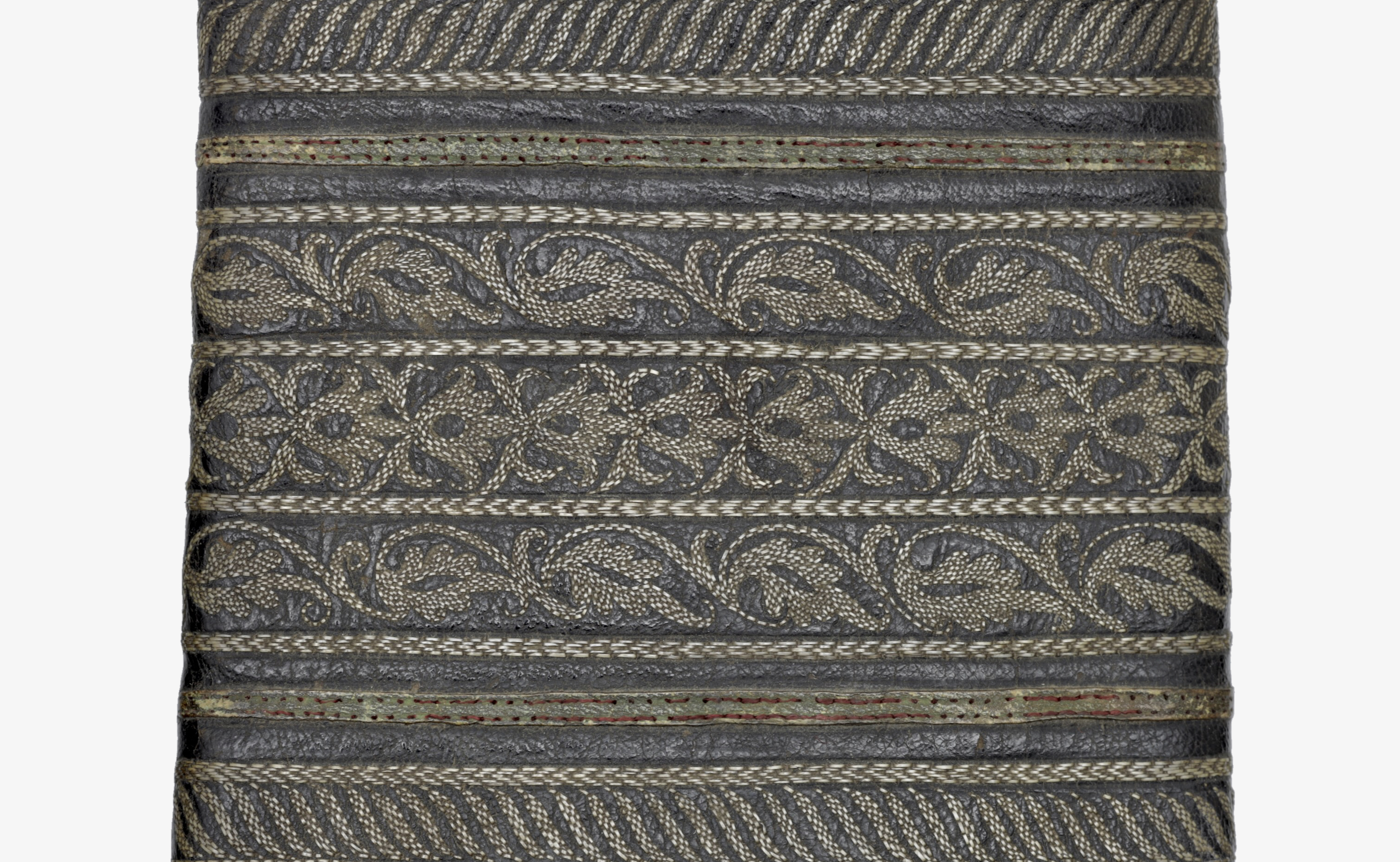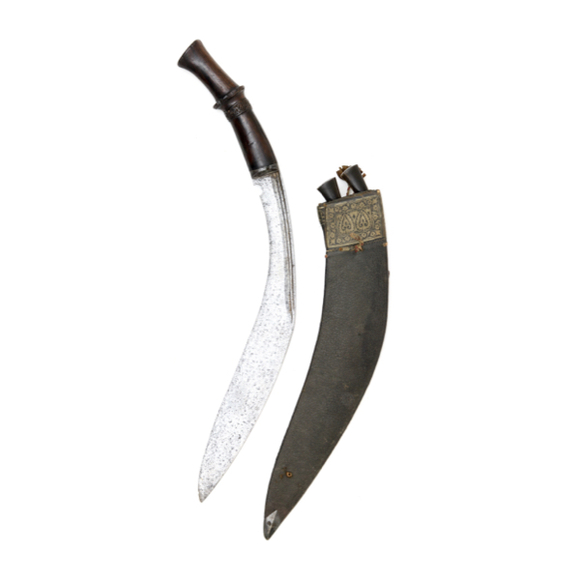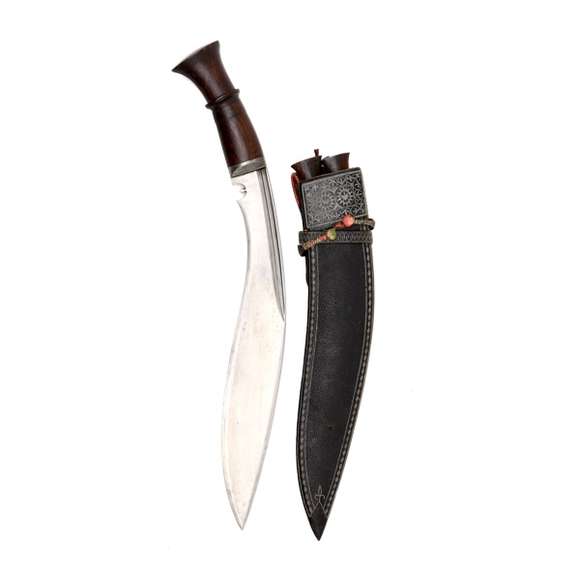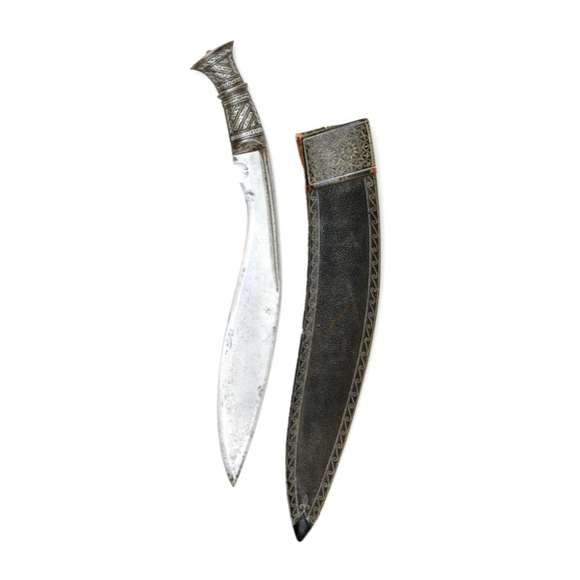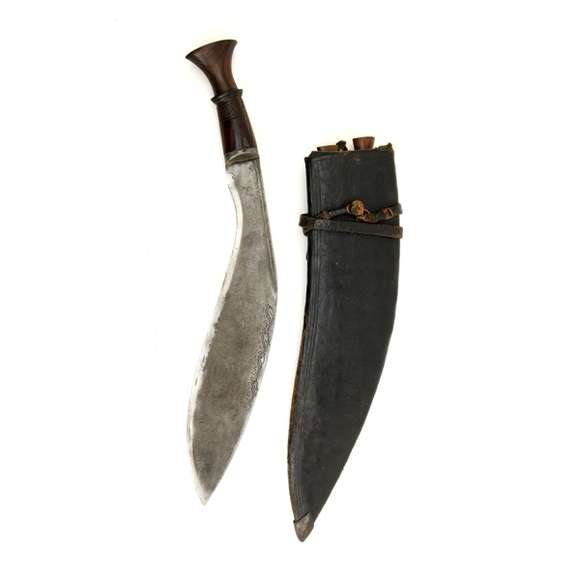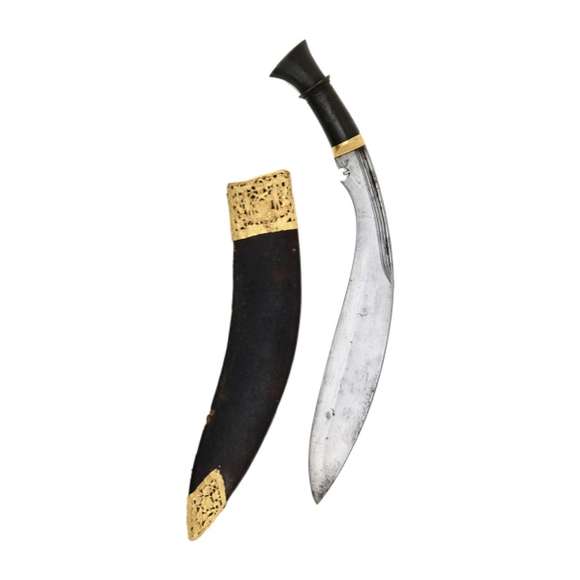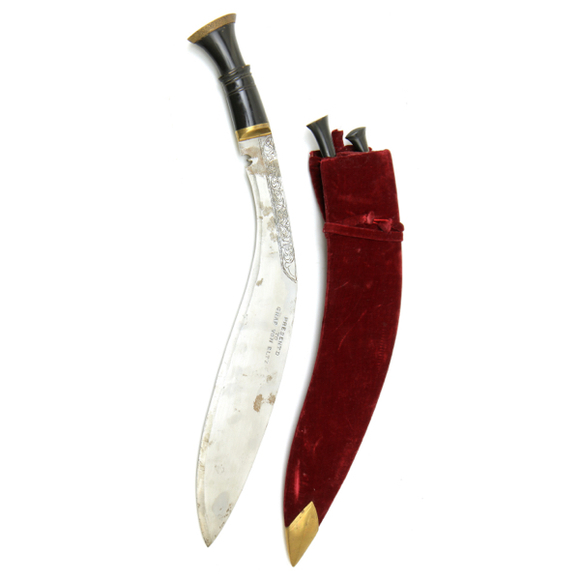Introduction
Scabbards of antique Nepalese khora swords and khukurī knives sometimes exhibit a peculiar type of embroidery that uses quill strips from peacock feathers. I am very fond of this type of work; the better examples show incredible skill without being overly showy.
The work can be incredibly fine, yet very little was ever written about it. Most pieces appear to be attributable to 1800 to circa the 1850s. After that, the application seems to vanish, at least from scabbards, never to return again.
In this article, I will summarize what little I have on the subject and show some examples of the work.

An ivory-hilted khukurī with very fine quill embroidery on its scabbard. Circa 1840s-50s.
It has an unknown collection number 1397 painted on the blade.
Private collection.

Close-up of the quill embroidery of the above example.
On extant examples the embroidery is always done on a separate piece of leather of finer grain than the rest of the scabbard, as seen here.
Earliest evidence of Nepalese quill embroidery, 1793-1811
East India Company officer William Kirkpatrick (1754–1812) was the first European to visit Nepal. He was sent on a diplomatic mission in 1793, and wrote the first English language description of the country and its people; An Account of the Kingdom of Nepaul, being the substance of observations made during a mission to that country in the year 1793.
It was published in London in 1811. It is important for our study because it contains our earliest dated illustration of a khukurī and kora, both exhibiting what is certainly quill embroidery.

Khukurī and kora as depicted in Kirkpatrick's 1811 account of the Kingdom of Nepal.
They were likely bringbacks from the 1793 mission, current whereabouts unknown.
The Fraser album, 1815-1816
The next earliest depiction of quill embroidery on khukurī scabbards is on some folios of the Fraser Album, dating from 1815-1816. William Fraser was the first to recruit Ghurkas into the British army. He is best known for the many paintings he commissioned of different people in the area, which are today an important source for study of their arms and appearance.
In this case we see clear white on black background decor, something only seen on antiques in the form of quill embroidery.

"Eight Ghurkas" Haryana, circa 1815-1816.
25.4 x 40.4 cm. Private Collection.
The painting is inscribed with the names of the people depicted in Persian, transcribed by William Fraser, who was adept in many of the local languages:
"Dhunneea, a Thappa of Ascham.
Joogeea, a Thappa of Ascham, a petty Rajship West of Nepal
Beeroo, a goorung of Goorka. The only real Ghorka.
Poorun, cast Thappa Mugur, of Tunnoo.
Runbeer, a goorung, of Tunnoo rajship, subject to Nepal.
Muneea, Rana cast, of Caskee.
Seeoobur, a house servant of the Nepal Rajah, Country Caskee, subject to Nepal.
Ramchunder, cast goorung of the little Rajship Lumjoong, subject to West of Nepal - his vil Tarkar"
The painting is important because it is the first and one of the few historical depictions known of the so-called hanshee khukurī.

A hanshee khukurī of circa 1790s-1820s.
Private collection.

Close-up of quill embroidery on the above example.
In the literature, Egerton 1880
Nepalese quill embroidery as applied on arms is typically found only in the descriptions of physical items. The first such descriptions go back to Egerton's landmark work "An Illustrated Handbook of Indian Arms" of 1880. The last number of each entry is when the piece entered the India Museum collection in London. Upon its closing in 1879, many of the pieces went to the South Kensington Museum, renamed Victoria & Albert Museum in 1899.
318.* Sword; “Kukri; 55 bright blade, the back edge perforated at intervals; hilt of dark wood; sheath of black leather, ornamented with quill embroidery.
Nepal. Presented by the late Sir Jung Bahadur.
L. 18 in. (11. iX., No. 31g.) (8709.-'55.)
320.* Sword; "Kukri;" plain bright blade; black wooden hilt; leather sheath, embroidered with peacock quills, with two small knives attached in a receptacle at the side.
Nepal. L. 19 in. ; W. 1 in. to 2 in. (8688.-'55.)
331.* Sword; "Kora." The back of the blade is channelled, the grooves being gilt; steel hilt, with circular guard disks; sheath of black leather, embroidered with peacock quills and enriched with perforated and embossed mounts of fine gold.
Nepal. Presented by the Marquis of Hastings.
L. 2 ft. 4 in. ; W. of blade, 1 in. to 4 in. (8677.-'50.)
356. Powder-Flask; "Batwál túmbi;" (powder-gourd), of leather, embroidered with coloured thread and strips of porcupine quill.
Nepal. (8726.- '55.)
357. Pouch; leather, embroidered with strips of coloured quills in pine pattern.
Nepal. (8731.-'55.)
-Lord Wilbraham Egerton
"An Illustrated Handbook of Indian Arms"
W.H. Allen, London. 1880. Pages 101-102.
The khukurī mentioned above is preserved in the Victoria and Albert Museum. Their collection database mentions it was presented to William Tayler, a civil servant of the East India Company, by Sir Jung Bahadur, who served as prime minister of Nepal from 1846-1856.

Khukurī presented by Jung Bahadur in 1855.
Victoria & Albert Museum, accession number 2560(IS).
The kora is also preserved in the same museum. It was presented to the East India Company by the Marquis of Hastings, Governor General of India (1813-23). This must have happened prior to his death in 1826. It entered the India Museum in 1850 and was subsequently moved to the South Kensington museum, now known as Victoria & Albert Museum, in 1879. It is one of the best kora swords known in the world today.

Nepalese kora sword with golden overlaid grooves and dimples.
Its scabbard with peacock quill embroidery and gold filigree mounts.
Victoria & Albert Museum accession number 2554&A(IS).
Another one in Egerton's work is just described as having embroidery, but it, too is preserved in the Victoria & Albert and clearly exhibits the same fine peacock quill embroidery seen on the others. Egerton's description:
"317.* Sword; "Kukri;" bright steel blade; ivory hilt, ornamented with bands of floriated scroll-work; embroidered black leather sheath,
with small side sheath attached, enclosing two miniature Kukris, with ivory hilts, stained red and green respectively, and carved into grotesque heads.
Nepal. Presented by the late Sir Jung Bahadur.
L. 19 in.; W. of blade, li in. to 24 in. (8689.-'51.)"
The piece in the Victora & Albert Museum:

Fine khukurī, presented by Sir Jung Bahadur to the East India Company in 1851.
Victoria & Albert Accession number 2561(IS).
Egerton mentions the use of peacock quill specifically on some of the scabbard work, while he mentions porcupine on the powder flask. Native American Indian quillwork typically uses porcupine, while peacock was also preferred in Austrian quillwork done mainly in Tyrol, where it is called federkielstickerei.
Quill embroidered wares sold at Simla, 1872
Lord Baden Powell, in 1872, writes:
"674.-[8255-6-7 etc.] Ornamental leather work exhibited by the Rajas of Kyuntbal, Bilàspur etc.
These articles consist of glove boxes and other fancy boxes, cigar cases, etc., made out of stout black leather lined with red leather; the surface is sometimes variegated with patterns of red, green, and gilt leather, but the distinguishing feature is that the whole is embroidered over in a white pattern with narrow slips of the quill of the peacock. The work is done, not at Simla, but in villages in the Kangra district and elsewhere, the work being mostly taken for sale to Simla. The men can work to order, initials and even create on the leather. The work is remarkably cheap— a cigar case costs from 14 annas to 1 rupee."
-Baden Henry Baden-Powell;
Handbook Of The Manufactures And Arts Of The Punjab
Lahore, Punjab Printing Company, Lahore. 1872. Page 126.
The villages he says these articles are from are situated in present-day Himachal Pradesh, on the western Himalayan foothills. Kangra district is just northwest of Simla.

Simla is on the red marker.
Simla has an interesting history; it was conquered by Bhimsen Thapa of Nepal in 1806, and a considerable number of Ghurkas were stationed in the area.
"The Gurkhas, who were rather restless in 1775 or thereabouts, started on a campaign for the extension of their territories towards the present Simla District, at the expense of the hill chiefs; so in 1815, Sir David Ochterlony paid them a state visit with the usual number of guns.
As a result of this visit John Company was persuaded, much against his policy, to accept certain of the hill tracts from tbe Gurkhas as military out-posts."
-Doz (alias of D.O. Sullivan)
Simla in Ragtime. An Illustrated Guide Book.
Station Press, 1913. Page 5.
Simla fell into British hands after the Anglo-Nepalese War of 1814-1816, which was concluded with the Treaty of Sugauli on 4 March 1816. This treaty established Nepal as a sovereign ally of the British, and established its current borders.
Quillwork in the 1886 and 1888 Journal of Indian Art
John Lockwood Kipling was the principal of the Mayo School of Industrial Arts, Lahore, and curator of the Lahore Museum in the adjacent building. Fun fact: He was the father of Joseph Rudyard Kipling , author of the Jungle Book.
In 1886 he wrote:
"LOCAL VARIETIES.—Bilaspur leather and quill boxes, cigar cases, belts, trappings, &c.
DESCRIPTIVE REMARKS.—This quaint and curious work is produced in the Bilaspur State and a little elsewhere also. Black leather is first made into boxes and other forms, then decorated with circles or patterns of green or red leather or leather covered with foil fastened on in the manner of appliqué work, and then the whole is sewed in designs of white with thin strips of tough and flexible quills of the peacock. The work is probably of Gurkha origin."
-John Lockwood Kipling, Principal, Mayo School of Art, Lahore
Journal of Indian Art, Vol 2.
W. Griggs, London, 1886. Supplement, page 8.
Bilaspur is about 80 kilometers northwest of Simla, also in the Himalayan foothills.
Kipling wrote the Industries of the Punjab for the Punjab Gazetteer, which was reprinted in the Journal of Indian Art of 1888. In the chapter describing Simla, he writes:
"LEATHER AND QUILL Work.—In Bilaspur, one of the feudatory Hill States, small leather boxes, cigar-cases and book-covers are made and occasionally brought into Simla for sale. The groundwork of these articles is black leather diversified by inserted pieces of emerald green, red or gilt leather with lines of stitching in white threads, which are really filaments of peacock feather quills. The boxes are lined inside with red leather and are fairly durable, except the peacock quill stitching, which (in India) is promptly destroyed by insects. Similar work is wrought at Anandpur in the Hoshiarpur district. The craft, such as it is, seems to be more skilfully practised in Nepal than elsewhere, and it was probably introduced into the Punjab Himalaya during the time of the Gurkha occupation."
-John Lockwood Kipling, Principal, Mayo School of Art, Lahore
Journal of Indian Art, Vol 2.
W. Griggs, London, 1888. Page 37.
Quillwork at Bilaspur, Anandpur and Nepal in 1903
The last mention of peacock quill embroidery practiced in the region is found in 1903, this time attributed to Hoshiarpur and Nepal.
"Small boxes, such as pen-cases, cigar-boxes, dressing-cases, etc., are produced at BlLASPUR and at ANANDPUR in Hoshiarpor District, as also in NEPAL. These are in black leather ornamented with green and other coloured portions sewn on the surface With peacock quills which are in addition made to embroider the surface."
-Sir George Watt
Indian Art at Delhi
Calcutta, 1903. Page 201.
Hoshiarpur is about 150 km Northwest of Simla, mentioned in 1872. The articles produced are generally the same.
Terminology in dictionaries
Sir Ralph Lilley Turner's A Comparative and Etymological Dictionary of the Nepali Language of 1931 mentions some terms relating to this type of work.1
Bēl (बेल्), embroidery work.
Bel-buṭṭā (बेल्-बुट्टा), scroll-work embroidered on a khukurī sheath.
Bēlahari (बेलहरि), embroidery, scroll-work. (From bēl, embroidery and lahari, wave.)
Bēlahari buṭṭā (बेलहरि बुट्टा) / bel-buṭṭā, scroll-work on a khukri sheath.
Buṭṭā (बुट्टा), embroidery; braid; filigree work.
Haikale buṭṭā (हैकले बुट्टा), ornamentation consisting of lines of hooks.
Mākhe buṭṭā (माखे बुट्टा) / Makkhi-buṭṭā (मक्खि-बुट्टा) ornamentation consisting of lines of small dots, or resembling flies.
Jire buṭṭā (जिरे बुट्टा), fluted ornamentation.
Pwã̄kha ko kalam, quill pen.
Sã̄gle buṭṭā (साँगले बुट्टा), ornamentation in chains.
Notes
1. Sir Ralph Lilley Turner (1888 - 1983) was a Cambridge-educated man who went to India to serve as a lecturer. When the First World War broke out he served with the 2nd battalion, 3rd Queen Alexandra's Own Gurkha Rifles in the British Indian Army from 1915 - 1919. During this time he was awarded the Military Cross for "exemplary gallantry" for his service with the Gurkhas in Palestine. After the war he returned to his scholarly career in linguistics and served as a Professor of Indian Linguistics at Benares, Uttar Pradesh, and later as Professor of Sanskrit in London. In 1931, he wrote "A Comparative and Etymological Dictionary of the Nepali Language," from which these terms were sourced.
Some more examples of Nepalese quill embroidery
The earliest provenanced khukurī with quill embroidery is in the Pitt Rivers Museum.
It was collected by Frederick John Shore on or before 1830. Shore was an East India Company civil servant and judge, but was openly critical towards the company and insisted on wearing Indian clothes. In 1824 he fought a local uprising, alongside Frederick Young and 350 of his Sirmoor Batallion of Gurkhas. Shore received a number of deep saber cuts during a sword fight, remained in poor health since, and died 13 years later in 1837.

Frederick John Shore's hanshee khukurī. Entered the Pitt Rivers collection on or before 1830. It dates from circa 1800-1820s.
Pitt Rivers museum accession number 1886.1.33.1-4.
The Metropolitan Museum in New York has an early hanshee khukurī with comparably coarse quill work. It probably dates from circa 1790-1820.

Metropolitan Museum accession number 36.25.826a–g.
Provenance: William Ockelford Oldman, George Cameron Stone. Bequeathed to the museum in 1935.

Khukurī with quill embroidery, previously sold by Mandarin Mansion.
Circa 1850s.

Close-up of the embroidery. Although technically excellent, the design is a little stiffer than most earlier examples.
This probably represents the last stage in the development of this art.
Conclusion
Who exactly made this incredibly fine peacock quill embroidery remains a bit of a mystery. We have very few eyewitness accounts from Nepal of the period, but none describe any craftsmanship in great detail. The only period reports we have are from British authors, who describe peacock quill embroidery done in areas that were briefly occupied by the Nepalese in the late 18th to early 19th century, up until the Anglo-Nepalese War of 1814-1816 pushed them back and established Nepal's current borders. This view is shared by Kipling, cited earlier;
"The craft, such as it is, seems to be more skilfully practised in Nepal than elsewhere, and it was probably introduced into the Punjab Himalaya during the time of the Gurkha occupation."
The work described are mainly articles for European use: small leather boxes, cigar-cases, book-covers, belts and trappings. This reminds me of former armorers and koftgars in the Punjab area who started to make gold overlaid boxes and other articles for the European market after the fall of the Sikh Empire stopped the arms trade in the region. Similarly, the quill embroiderers in the Western Himalayan foothills found themselves out of a job once the Gukrhas were pushed back into Nepal.

